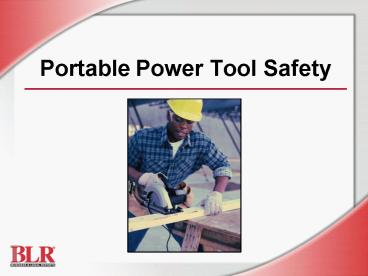Portable Power Tool Safety - PowerPoint PPT Presentation
1 / 19
Title:
Portable Power Tool Safety
Description:
Explosion or fire when sparks from a tool ignite flammable or ... Use fire curtains near flammables Business & Legal Reports, Inc. 0606. Tool Guards ... – PowerPoint PPT presentation
Number of Views:1422
Avg rating:3.0/5.0
Title: Portable Power Tool Safety
1
Portable Power Tool Safety
2
Session Objectives
- You will be able to
- Identify the hazards of portable power tools
- Take precautions against injury
- Use tool guards effectively
- Understand common safety practices for specific
types of tools
3
Types of Portable Power Tools
- Electric
- Pneumatic (air)
- Liquid fuel
- Hydraulic
- Powder-actuated
4
Portable Power Tool Hazards
- Hit by flying debris
- Hit by broken tool part
- Puncture with a sharp tool
- Explosion or fire when sparks from a tool ignite
flammable or combustible materials - Electric shock from a frayed or defective power
cord - Musculoskeletal disorders (MSDs) from repetitive
misuse of a tool
5
General Precautions for Operating Power Tools
- Never carry a tool or unplug it by the cord or
hose - Disconnect tools when they are not in use
- Make sure observers are at a safe distance
- Secure work with a vise, clamp, or other support
- Keep cords and hoses away from heat, liquids, and
sharp edges - Examine tools before each use
6
General Precautions (cont.)
- Keep cutting tools sharp and lubricated
- Do not wear loose clothes, ties, or jewelry
- Tie back long hair
- Mark or tag all damaged tools with Do Not Use
- Always wear personal protective equipment (PPE)
appropriate to the work - Use fire curtains near flammables
7
Tool Guards
- Guards protect from
- Point of operation hazards
- Nip points
- Rotating parts
- Flying chips or sparks
8
Guarded Power Tool Parts
- Gears, sprockets, and sprocket chain drives
- Belt and pulley drives, pulleys and drums
- Hazardous revolving or reciprocating parts
- Exposed shafts and projecting shaft ends
- Collars, clutches, and couplings
9
Protect YourselfUse Guards
- Never operate a tool without its guard in place
- Use the guard supplied by the tool manufacturer
- Never remove or disable guards
- Report any missing, broken, or disabled guards
10
Electric Tool Safety
- Operate tools within their design limitations
- Wear appropriate gloves and footwear
- Store tools in a dry location
- Do not use them in wet or damp locations
- Work areas should be well lighted
11
Power Grinder Safety
- Always use eye protection
- Turn off power when its not in use
- Never clamp a hand-held grinder in a vise
12
Pneumatic Tool Safety
- Always wear eye and hearing protection
- Make sure air hose connections are secure
- Ensure the safety clip for attachments is
installed and secure - Use screens to protect nearby workers
- Never point the tool at anyone
13
Safety with Powder-Actuated Tools
- Do not use in an explosive or flammable
atmosphere - Inspect the tool prior to use
- Never point the tool at anyone
- Load the tool only when it is going to be used
- Keep hands clear of the barrel end
14
Jack Safety
- Set up a jack so that the base rests on a firm,
level surface - Make sure the jack is centered
- Ensure that the jack head is against a level
surface - Be certain the lift force is applied evenly
15
Safety Switches
- Positive On-Off
- Platen sanders, disc sanders, and grinders with
less than 2-diameter discs, shears, and scroll
saws - Momentary On-Off
- Drills tappers fastener drivers horizontal,
vertical, and angle grinders disc and belt
sanders and reciprocating and saber saws - Constant pressure switchauto shut off
- Circular saws and chain saws
16
Whats Wrong with This Picture?
- Employee was cutting plywood with a circular saw
- He tapes back the lower blade guard
- He holds the wood
- The saw catches in wood and kicks back
- The saw hit the employee in the abdomen, leaving
a 10 laceration
17
What Caused the Accident?
18
What Should Have Been Done?
- How could this worker have cut the board safely?
- What type of PPE should be worn?
19
Key Points to Remember
- Keep all tools regularly maintained
- Use the right tool for the job
- Examine each tool for damage before use
- Operate tools in accordance with the
manufacturers instructions - Provide and use the proper personal protective
equipment































